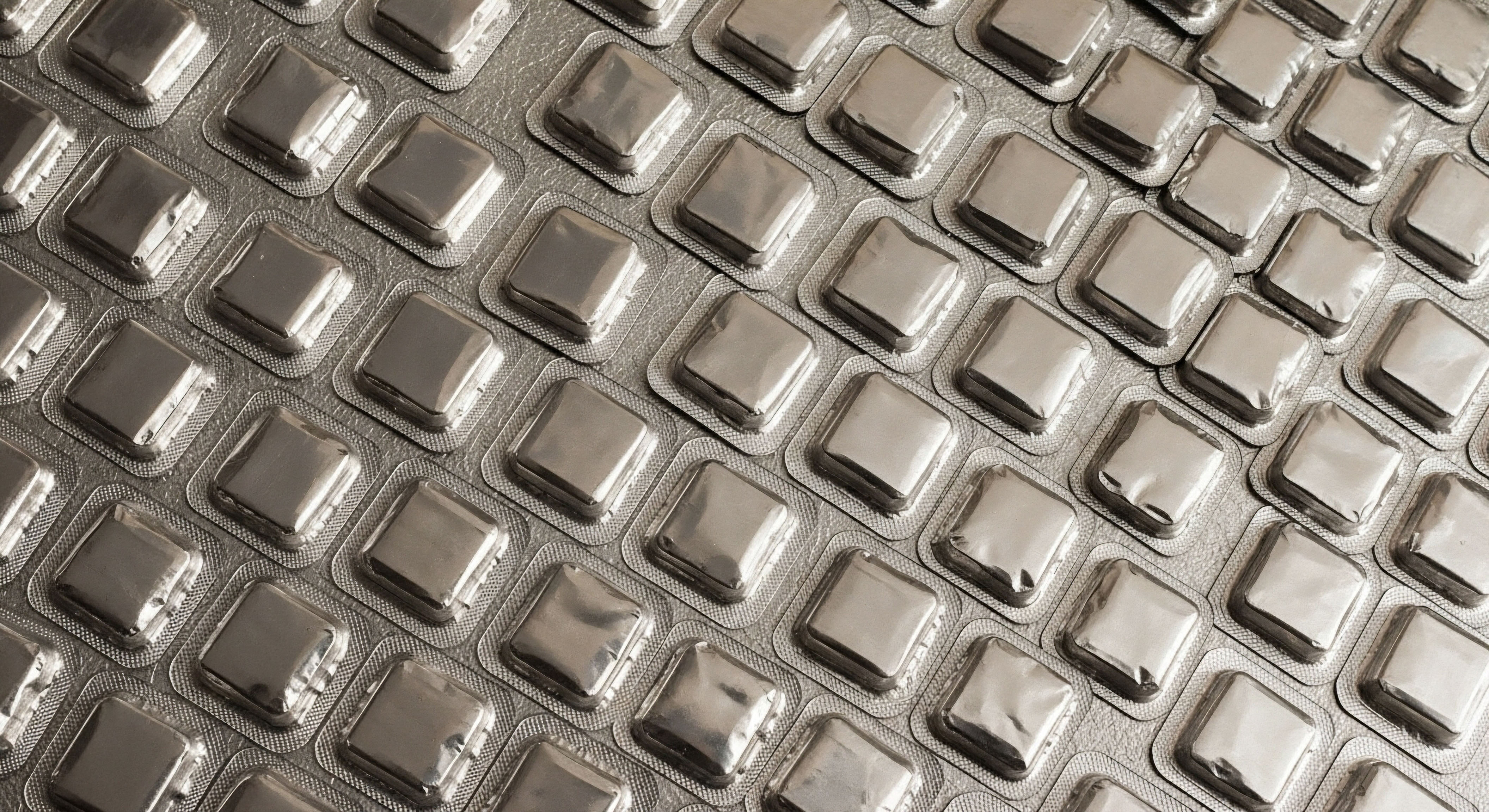

Fundamentals
You have embarked on a meticulous process of biochemical recalibration, a personal commitment to restoring your body’s intended function. You track your symptoms, adhere to your protocol, and anticipate the return of vitality. Yet, a common question arises, one that touches on the intersection of this clinical precision and the realities of social life ∞ can you still enjoy a drink?
The concern is valid and deeply personal. It stems from an intuitive understanding that a substance like alcohol might interact with the very systems you are working so diligently to support. This is not a question of morality, but one of mechanics. You are the steward of a complex biological system, and you need to understand how all inputs affect the output.
At the heart of this interaction is the body’s master control system for sex hormones, the Hypothalamic-Pituitary-Gonadal (HPG) axis. Think of this as a sophisticated communication network. The hypothalamus, a region in your brain, sends a signal (Gonadotropin-releasing hormone, or GnRH) to the pituitary gland.
The pituitary, in turn, releases two messenger hormones, Luteinizing Hormone (LH) and Follicle-Stimulating Hormone (FSH), into the bloodstream. These messengers travel to the gonads (testes in men, ovaries in women) with precise instructions to produce testosterone or estrogen. This entire network operates on a feedback loop; when sex hormone levels are optimal, the hypothalamus and pituitary reduce their signals. It is a self-regulating system of immense elegance.
Alcohol directly intervenes in the body’s intricate hormonal signaling and metabolic processes, creating systemic disruption.
When alcohol enters this system, it acts as a powerful disruptor. It does not simply add a single variable; it creates noise across the entire communication channel. The primary site of this disruption is the liver, the body’s master metabolic clearinghouse.
Your liver is tasked with deactivating and preparing substances for removal, including both the hormones from your therapeutic protocol and the ethanol from an alcoholic beverage. The liver, however, prioritizes metabolizing alcohol above all else. This metabolic prioritization creates a backlog. The carefully timed administration of your hormone therapy depends on predictable absorption and breakdown.
When the liver is occupied with processing alcohol, the clearance of therapeutic hormones can be delayed, leading to unpredictable spikes and troughs in your levels. This variability can undermine the stability your protocol aims to achieve, potentially reintroducing the very symptoms you sought to alleviate.

The Central Nervous System Connection
The influence of alcohol extends beyond the liver and directly into the central command of the HPG axis. Ethanol has a well-documented suppressive effect on the hypothalamus and pituitary gland. It can dampen the release of LH, the primary signal for testosterone production in men.
For an individual on Testosterone Replacement Therapy (TRT), this might seem less relevant, as testosterone is being supplied exogenously. The use of adjunctive therapies like Gonadorelin, which directly stimulates the pituitary to maintain natural testicular function, is directly impeded by alcohol’s suppressive action. The signal from the Gonadorelin may be sent, but a suppressed pituitary is less capable of receiving it and responding appropriately. This interference can compromise the goal of maintaining testicular health and function while on therapy.

What Is the Direct Impact on Hormonal Balance?
For women undergoing hormonal optimization, particularly with estrogen, alcohol presents a different but equally significant challenge. Alcohol consumption can increase the conversion of androgens to estrogen by stimulating an enzyme called aromatase, particularly in the liver. This can lead to an unpredictable elevation in estrogen levels, compounding the effects of therapy and potentially increasing the risk of estrogen-sensitive side effects.
Furthermore, alcohol can intensify symptoms commonly managed by HRT, such as hot flashes and night sweats, by acting as a vasodilator and disrupting the body’s temperature regulation. It can also interfere with sleep architecture, which is critical for the natural diurnal rhythm of hormone release, including growth hormone and cortisol. The result is a system thrown into disarray, where the therapeutic signals of your protocol are competing with the chaotic signals introduced by alcohol.


Intermediate
Understanding that alcohol disrupts hormonal signaling is the first step. The next is to examine the precise mechanisms through which it interferes with the sophisticated clinical protocols designed for your wellness. These protocols are not monolithic; they are multi-faceted strategies involving specific agents like Testosterone Cypionate, Anastrozole, Gonadorelin, and various peptides. Each component has a distinct role, and alcohol’s impact is equally specific, creating a cascade of biochemical consequences that can compromise your therapeutic goals.

Interference with Core TRT Protocols
A standard male hormone optimization protocol is a carefully balanced system. It involves replacing testosterone while managing its potential downstream metabolites and maintaining the body’s own signaling pathways. Alcohol systematically degrades the efficacy of each component.
- Testosterone Cypionate ∞ This is the foundational element, providing a steady, exogenous source of testosterone. The metabolism of this esterified testosterone relies heavily on liver function for clearance. Chronic or acute alcohol consumption places a significant burden on the liver, which prioritizes ethanol detoxification. This can alter the pharmacokinetics of testosterone, leading to less predictable blood levels and potentially blunting the intended benefits of stable dosing.
- Anastrozole ∞ This compound is an aromatase inhibitor, prescribed to block the conversion of testosterone into estrogen, thereby managing potential side effects like gynecomastia and water retention. Alcohol consumption directly counters this action. Ethanol has been shown to increase aromatase activity, particularly in the liver. This creates a scenario where you are administering a medication to block an enzyme while simultaneously consuming a substance that stimulates it. The result is a biochemical tug-of-war that can lead to elevated estrogen levels despite adherence to the protocol.
- Gonadorelin or HCG ∞ These agents are used to mimic the body’s natural signals (GnRH and LH, respectively) to maintain testicular size and endogenous hormone production. Their efficacy depends on a responsive pituitary gland and healthy testicular Leydig cells. Alcohol directly suppresses pituitary function, reducing its sensitivity to Gonadorelin. It also exerts a direct toxic effect on the Leydig cells in the testes, impairing their ability to produce testosterone even when properly stimulated. Therefore, alcohol undermines both the signal and the response.

How Does Alcohol Affect Female Hormone Protocols?
For women on hormonal support, whether for perimenopausal symptoms or general wellness, the introduction of alcohol can be similarly disruptive. Protocols often involve a delicate balance of testosterone, progesterone, and sometimes pellet therapy.
Acute alcohol use in postmenopausal women on HRT has been shown to cause a temporary spike in estradiol levels, likely due to impaired liver metabolism. This creates hormonal volatility. For women using low-dose testosterone, alcohol’s effect on aromatase can unpredictably increase estrogen conversion, altering the intended testosterone-to-estrogen ratio that is so critical for mood, libido, and cognitive function.
Progesterone’s calming, sleep-promoting benefits can also be negated by alcohol’s known disruption of sleep cycles, particularly REM sleep. This can counteract one of the primary benefits sought with progesterone therapy.
Strategic lifestyle adjustments can create a biological environment that enhances the efficacy of hormone therapy and builds resilience against metabolic stressors.
The table below outlines specific lifestyle adjustments that can help fortify your system against the metabolic disruptions caused by alcohol, thereby supporting the intended outcomes of your hormone therapy.
| Lifestyle Adjustment | Mechanism of Action | Direct Support for Hormone Protocol |
|---|---|---|
| Nutrient-Dense Diet | Provides essential cofactors (B-vitamins, zinc, magnesium) for liver detoxification pathways (Phase I and Phase II) and hormone metabolism. High-fiber intake supports gut health and estrogen clearance. | Enhances the liver’s capacity to metabolize therapeutic hormones and manage ethanol byproducts, reducing metabolic backlog. Supports healthy gut microbiome, which regulates circulating estrogen levels. |
| Strategic Hydration | Alcohol is a diuretic and causes dehydration, which concentrates toxins and strains the kidneys. Adequate water intake supports renal clearance and maintains cellular function. | Ensures optimal blood volume and cellular health, allowing for efficient transport and receptor uptake of hormones. Mitigates the cellular stress caused by dehydration. |
| Consistent Resistance Training | Improves insulin sensitivity, increases muscle mass (a primary site for glucose disposal), and enhances endogenous production of beneficial hormones like growth hormone. | Counters alcohol-induced insulin resistance. Improved insulin sensitivity enhances cellular response to anabolic signals from TRT and peptide therapies. |
| Prioritized Sleep Hygiene | Secures the deep and REM sleep phases essential for pituitary function, growth hormone release, and cortisol regulation. Alcohol severely disrupts these stages. | Maximizes the efficacy of growth hormone peptides (e.g. Sermorelin, Ipamorelin) which rely on the natural nocturnal pulse. A regulated cortisol rhythm prevents adrenal strain that can be exacerbated by alcohol. |

The Unseen Impact on Peptide Therapies
Peptide therapies, such as Sermorelin or Ipamorelin/CJC-1295, are designed to stimulate the body’s own production of growth hormone (GH). The success of these protocols is entirely dependent on a healthy, functioning pituitary gland and a natural, physiological release pattern, which is strongest during deep sleep.
Alcohol is a potent suppressor of natural GH release. A single evening of drinking can virtually eliminate the nocturnal GH pulse. This directly counteracts the therapeutic goal of the peptide protocol. You are essentially applying the accelerator and the brake simultaneously, resulting in a blunted response and diminished returns on your investment in recovery and vitality.


Academic
A sophisticated analysis of alcohol’s interference with hormonal optimization protocols requires moving beyond systemic descriptions to a detailed examination of the molecular and cellular mechanisms. The interaction is not a simple collision of substances but a multi-level biochemical sabotage that alters enzymatic activity, gene expression, and receptor sensitivity. The primary arenas for this conflict are the liver’s cytochrome P450 enzyme system, the integrity of the gut-liver axis, and the neuroendocrine control of the HPG axis.

Hepatic Enzyme Induction and Competitive Inhibition
The liver metabolizes both steroid hormones and ethanol, but through distinct and sometimes overlapping pathways. Exogenous testosterone and endogenous estrogens are primarily metabolized by the cytochrome P450 (CYP) family of enzymes, particularly CYP3A4. Ethanol, conversely, is metabolized mainly by alcohol dehydrogenase (ADH) and, at higher concentrations, the Microsomal Ethanol-Oxidizing System (MEOS), which heavily involves the CYP2E1 enzyme.
Chronic alcohol consumption leads to the induction, or upregulation, of CYP2E1. This increased enzymatic machinery generates higher levels of reactive oxygen species (ROS) and acetaldehyde, a highly toxic metabolite. This state of oxidative stress can impair the function of other CYP enzymes, including the CYP3A4 needed for proper hormone clearance.
The result is a less efficient, more toxic hepatic environment. Furthermore, the process of metabolizing ethanol consumes critical cofactors, such as nicotinamide adenine dinucleotide (NAD+). The depletion of the NAD+/NADH ratio directly inhibits key steps in steroidogenesis, including the conversion of pregnenolone to progesterone, providing a direct mechanism for alcohol’s suppressive effect on endogenous hormone synthesis.
The table below details the specific enzymatic and metabolic disruptions caused by ethanol, contrasting them with the goals of common hormonal therapies.
| Metabolic Pathway | Effect of Ethanol Consumption | Consequence for Hormonal Protocols |
|---|---|---|
| Aromatase (CYP19A1) Activity | Ethanol and its metabolite acetaldehyde have been shown to increase aromatase expression and activity in hepatic and adipose tissue. | Directly counteracts the therapeutic action of aromatase inhibitors like Anastrozole, leading to a higher-than-expected conversion of testosterone to estradiol and compromising the protocol’s primary safety control. |
| Sex Hormone-Binding Globulin (SHBG) | Moderate alcohol intake can decrease SHBG production by the liver. SHBG binds to sex hormones, regulating their bioavailability. | A decrease in SHBG leads to a higher percentage of free, unbound testosterone and estrogen. While this may seem beneficial for testosterone, the concurrent increase in aromatase activity means more substrate is available for conversion to estrogen, potentially exacerbating estrogenic side effects. |
| Glucuronidation (Phase II Detox) | The high metabolic load from alcohol can saturate Phase II detoxification pathways like glucuronidation, which are essential for conjugating and excreting hormone metabolites. | Impaired clearance of estrogen metabolites can lead to their recirculation and reabsorption, increasing the overall estrogenic burden on the body. This is particularly relevant for managing cancer risks associated with certain estrogen metabolites. |
| Insulin-like Growth Factor 1 (IGF-1) | Alcohol consumption, through direct hepatic toxicity and disruption of GH signaling, leads to decreased hepatic production and bioavailability of IGF-1. | Reduces the anabolic and restorative effects of both TRT and Growth Hormone Peptide Therapy. Many of the benefits attributed to GH are mediated by IGF-1, so its suppression is a critical point of failure. |

Disruption of the Gut-Liver Axis and Endotoxemia
The integrity of the gastrointestinal system is paramount for hormonal health. The gut microbiome contains bacteria that produce the enzyme β-glucuronidase, which can deconjugate estrogens that have been processed by the liver and excreted in bile. This deconjugation allows estrogen to be reabsorbed into circulation, a pathway known as the enterohepatic circulation of estrogens.
Alcohol consumption increases intestinal permeability, often called “leaky gut.” This allows bacterial components, specifically lipopolysaccharide (LPS), to enter the bloodstream. This condition, known as metabolic endotoxemia, triggers a low-grade systemic inflammatory response. This inflammation further burdens the liver and can dysregulate the gut microbiome, potentially increasing the activity of β-glucuronidase and leading to greater estrogen reabsorption and an overall higher estrogen load. This mechanism demonstrates how alcohol can disrupt hormonal balance systemically, starting from the gut.
The molecular interference of ethanol with hormonal therapy creates a state of functional resistance at the cellular level.

What Is the Neuroendocrine Impact on Pulsatility?
The efficacy of hormonal systems relies on pulsatile secretion. The hypothalamus releases GnRH in discrete pulses, which prevents the downregulation of its receptors on the pituitary. Growth hormone is also released in a pulsatile fashion, primarily at night. Alcohol disrupts this delicate chronobiology.
It alters the function of key neurotransmitter systems, particularly GABA (gamma-aminobutyric acid) and glutamate. By enhancing the inhibitory tone of GABA, alcohol suppresses the neuronal activity in the hypothalamus required for generating GnRH and GHRH (Growth Hormone-Releasing Hormone) pulses. This flattening of the pulsatile signal leads to reduced pituitary output of LH, FSH, and GH.
For a patient on a peptide protocol like Sermorelin, which works by augmenting the natural GHRH signal, alcohol’s suppression of the underlying pulse renders the therapy significantly less effective. The peptide may be present, but the fundamental biological rhythm it is designed to amplify has been silenced.
This multi-level analysis reveals that lifestyle adjustments, particularly the moderation or strategic elimination of alcohol, are not merely supportive measures. They are fundamental requirements for allowing sophisticated hormonal therapies to function as designed. They remove the competitive inhibitors, quell the systemic inflammation, and restore the physiological rhythms necessary for these protocols to achieve their clinical potential.
- Reducing Aromatase Upregulation ∞ The most direct way to support an Anastrozole protocol is to avoid substances that actively increase aromatase expression. Cruciferous vegetables (broccoli, cauliflower) contain compounds like indole-3-carbinol, which helps support healthy estrogen metabolism, providing a dietary counterbalance to potential disruptions.
- Protecting Hepatic Function ∞ Supporting the liver involves more than just avoiding toxins. Nutrients like N-acetylcysteine (NAC), a precursor to the master antioxidant glutathione, can help mitigate the oxidative stress generated by both alcohol metabolism and other metabolic processes. This preserves the liver’s capacity to handle its prescribed tasks, including hormone metabolism.
- Maintaining Gut Barrier Integrity ∞ A diet rich in prebiotic fiber and fermented foods can support a healthy gut microbiome, reinforcing the intestinal barrier. This reduces the risk of metabolic endotoxemia from any alcohol that is consumed, thereby lessening the systemic inflammatory load and its downstream effects on hormonal regulation.

References
- Erol, A. Ho, A. M. Winham, S. J. & Karpyak, V. M. (2019). Sex hormones in alcohol consumption ∞ a systematic review of evidence. Addiction biology, 24(2), 157 ∞ 169.
- Van Thiel, D. H. Gavaler, J. S. & Lester, R. (1975). Ethanol ∞ a gonadal toxin in the mature male rat. Endocrinology, 96(1), 267-272.
- Ginsburg, E. S. Mello, N. K. Mendelson, J. H. Barbieri, R. L. Teoh, S. K. Rothman, M. Gao, X. & Sholar, J. W. (1996). Effects of alcohol ingestion on estrogens in postmenopausal women. JAMA, 276(21), 1747 ∞ 1751.
- Purohit, V. (2000). Can alcohol promote aromatization of androgens to estrogens? A review. Alcohol, 22(3), 123-125.
- Rachdaoui, N. & Sarkar, D. K. (2017). Pathophysiology of the Effects of Alcohol Abuse on the Endocrine System. Alcohol research ∞ current reviews, 38(2), 255 ∞ 276.
- Sarkola, T. & Eriksson, C. J. (2003). Testosterone increases in men after a low dose of alcohol. Alcoholism, clinical and experimental research, 27(4), 682 ∞ 685.
- Emanuele, M. A. & Emanuele, N. V. (1998). Alcohol’s effects on female reproductive function. Alcohol research & health ∞ the journal of the National Institute on Alcohol Abuse and Alcoholism, 22(3), 195 ∞ 201.
- Dorgan, J. F. Baer, D. J. Albert, P. S. Judd, J. T. Brown, E. D. Corle, D. K. Campbell, W. S. Hartman, T. J. & Clevidence, B. A. (2001). The effects of alcohol and tomato juice on urinary estrogens in postmenopausal women. Journal of the National Cancer Institute, 93(13), 996 ∞ 1001.

Reflection
You now possess a detailed map of the biological terrain where your clinical protocol and lifestyle choices intersect. The data clarifies how a substance like alcohol can introduce static into a finely tuned system, from the molecular level to the grand rhythm of your body’s internal clock.
This knowledge is not a judgment. It is a tool. It transforms ambiguity into a series of clear, cause-and-effect relationships. Seeing these connections allows you to move from a position of passive hope to one of active, informed stewardship of your own biology.
The path forward is a personal calculation, weighing the value of a momentary indulgence against the cumulative progress of your health journey. This understanding is the foundation upon which you can build a strategy that aligns your daily actions with your ultimate goal ∞ a state of resilient and uncompromising vitality.

Glossary

pituitary gland

gonadorelin

alcohol consumption

growth hormone

testosterone cypionate

anastrozole

aromatase inhibitor

sermorelin

cytochrome p450

gut-liver axis

gut microbiome




